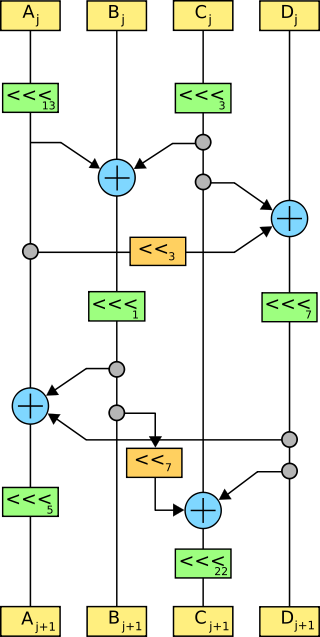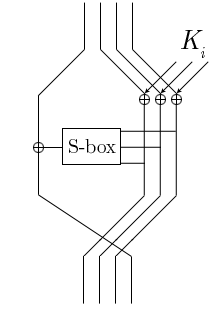Related Research Articles

The Advanced Encryption Standard (AES), also known by its original name Rijndael, is a specification for the encryption of electronic data established by the U.S. National Institute of Standards and Technology (NIST) in 2001.
In cryptography, a block cipher is a deterministic algorithm that operates on fixed-length groups of bits, called blocks. Block ciphers are the elementary building blocks of many cryptographic protocols. They are ubiquitous in the storage and exchange of data, where such data is secured and authenticated via encryption.

The Data Encryption Standard is a symmetric-key algorithm for the encryption of digital data. Although its short key length of 56 bits makes it too insecure for modern applications, it has been highly influential in the advancement of cryptography.

In cryptography, the International Data Encryption Algorithm (IDEA), originally called Improved Proposed Encryption Standard (IPES), is a symmetric-key block cipher designed by James Massey of ETH Zurich and Xuejia Lai and was first described in 1991. The algorithm was intended as a replacement for the Data Encryption Standard (DES). IDEA is a minor revision of an earlier cipher Proposed Encryption Standard (PES).
In cryptography, a Feistel cipher is a symmetric structure used in the construction of block ciphers, named after the German-born physicist and cryptographer Horst Feistel, who did pioneering research while working for IBM; it is also commonly known as a Feistel network. A large proportion of block ciphers use the scheme, including the US Data Encryption Standard, the Soviet/Russian GOST and the more recent Blowfish and Twofish ciphers. In a Feistel cipher, encryption and decryption are very similar operations, and both consist of iteratively running a function called a "round function" a fixed number of times.

Serpent is a symmetric key block cipher that was a finalist in the Advanced Encryption Standard (AES) contest, in which it ranked second to Rijndael. Serpent was designed by Ross Anderson, Eli Biham, and Lars Knudsen.
MARS is a block cipher that was IBM's submission to the Advanced Encryption Standard process. MARS was selected as an AES finalist in August 1999, after the AES2 conference in March 1999, where it was voted as the fifth and last finalist algorithm.

In cryptography, DES-X is a variant on the DES symmetric-key block cipher intended to increase the complexity of a brute-force attack. The technique used to increase the complexity is called key whitening.
In cryptography, SAFER is the name of a family of block ciphers designed primarily by James Massey on behalf of Cylink Corporation. The early SAFER K and SAFER SK designs share the same encryption function, but differ in the number of rounds and the key schedule. More recent versions — SAFER+ and SAFER++ — were submitted as candidates to the AES process and the NESSIE project respectively. All of the algorithms in the SAFER family are unpatented and available for unrestricted use.
In cryptography, Khufu and Khafre are two block ciphers designed by Ralph Merkle in 1989 while working at Xerox's Palo Alto Research Center. Along with Snefru, a cryptographic hash function, the ciphers were named after the Egyptian Pharaohs Khufu, Khafre and Sneferu.
In cryptography, LOKI89 and LOKI91 are symmetric-key block ciphers designed as possible replacements for the Data Encryption Standard (DES). The ciphers were developed based on a body of work analysing DES, and are very similar to DES in structure. The LOKI algorithms were named for Loki, the god of mischief in Norse mythology.

In cryptography, MacGuffin is a block cipher created in 1994 by Bruce Schneier and Matt Blaze at a Fast Software Encryption workshop. It was intended as a catalyst for analysis of a new cipher structure, known as Generalized Unbalanced Feistel Networks (GUFNs). The cryptanalysis proceeded very quickly, so quickly that the cipher was broken at the same workshop by Vincent Rijmen and Bart Preneel.
In cryptography, NewDES is a symmetric key block cipher. It was created in 1984–1985 by Robert Scott as a potential DES replacement.
SEED is a block cipher developed by the Korea Information Security Agency (KISA). It is used broadly throughout South Korean industry, but seldom found elsewhere. It gained popularity in Korea because 40-bit encryption was not considered strong enough, so the Korea Information Security Agency developed its own standard. However, this decision has historically limited the competition of web browsers in Korea, as no major SSL libraries or web browsers supported the SEED algorithm, requiring users to use an ActiveX control in Internet Explorer for secure web sites.
In cryptography, REDOC II and REDOC III are block ciphers designed by Michael Wood (cryptographer) for Cryptech Inc and are optimised for use in software. Both REDOC ciphers are patented.

In cryptography, ICE is a symmetric-key block cipher published by Kwan in 1997. The algorithm is similar in structure to DES, but with the addition of a key-dependent bit permutation in the round function. The key-dependent bit permutation is implemented efficiently in software. The ICE algorithm is not subject to patents, and the source code has been placed into the public domain.
In cryptography, Nimbus is a block cipher invented by Alexis Machado in 2000. It was submitted to the NESSIE project, but was not selected.
In cryptography, M6 is a block cipher proposed by Hitachi in 1997 for use in the IEEE 1394 FireWire standard. The design allows some freedom in choosing a few of the cipher's operations, so M6 is considered a family of ciphers. Due to export controls, M6 has not been fully published; nevertheless, a partial description of the algorithm based on a draft standard is given by Kelsey, et al. in their cryptanalysis of this family of ciphers.
In cryptography, New Data Seal (NDS) is a block cipher that was designed at IBM in 1975, based on the Lucifer algorithm that became DES.
The following outline is provided as an overview of and topical guide to cryptography:
References
- ↑ "QDLPluginEncryptionPS Reference - QDLPlgLucifer". www.patisoftware.eu. Retrieved 2020-11-22.
- ↑ Horst Feistel. Block Cipher Cryptographic System, US Patent 3,798,359. Filed June 30, 1971. (IBM)
- ↑ John Lynn Smith. Recirculating Block Cipher Cryptographic System, US Patent 3,796,830. Filed Nov 2, 1971. (IBM)
- ↑ Horst Feistel, (1973). Cryptography and Computer Privacy". Scientific American, 228(5), May 1973, pp 15–23.
- ↑ Sorkin, Arthur (1984). "Lucifer: a cryptographic algorithm". Cryptologia. 8 (1): 22–35. doi:10.1080/0161-118491858746.
- ↑ Ishai Ben-Aroya, Eli Biham (1996). Differential Cryptanalysis of Lucifer. Journal of Cryptology9(1), pp. 21–34, 1996.
- ↑ Konheim, Alan G. (2007), Computer Security and Cryptography, John Wiley & Sons, p. 283, ISBN 9780470083970 .